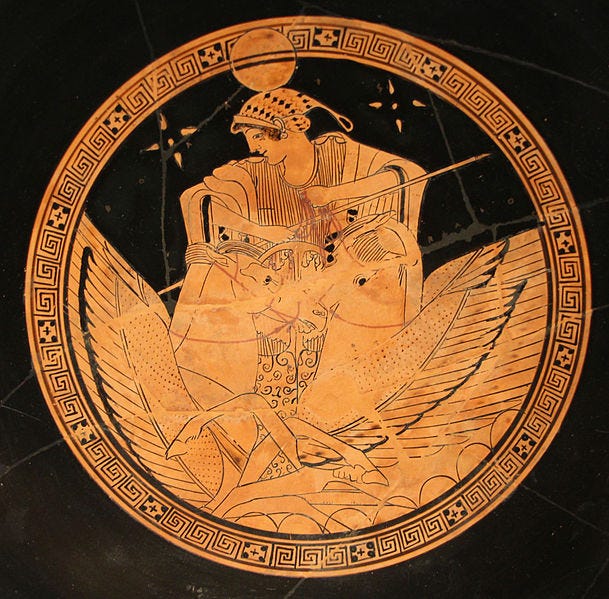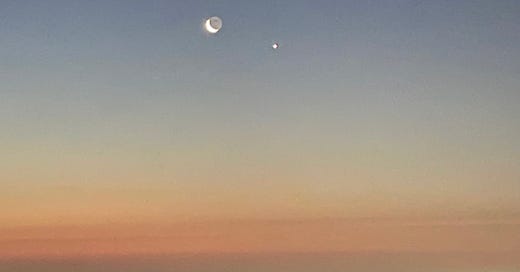Revealing the Mysteries, or, My New Translation of the Orphic Hymn to the Moon (Selene)
Part 1: The Translation Itself & a Meditation on Why Here, Why Now
What is so damn special about the Orphic Hymns?
I translated my first Orphic Hymn (to Hermes) back in the Spring of 2021, and the Hymn to the Moon shortly thereafter. Why? I have literally no idea other than that, after finishing translating Sappho’s major poems, I was looking around for something to occupy my anxious pandemic brain. A little interior voice said, “Find some ancient hymns to translate because it will quiet your mind,” so I did. Little did I know that it would change not just my own life, but (if my translations and theories are borne out), the way we think about ancient religion, magic, and astrology.
I’ve sat on my translations of the planetary hymns for over 18 months as I have continued to research and meditate. The result is truly HUGE—both in quantity of research (I have to release the Hymn to the Moon in three parts because of how far it exceeds Substack email limits) and, even more importantly, I believe, in its importance to the field of ancient esoterica.
A word about that claim, which I realize is almost absurdly grandiose.
I normally am a modest mouse. I’m happiest at a library carrel (remember those?) or in my cozy reading chair, and am skeptical of large claims about pretty much anything. (I am a member of Gen X, after all, and therefore proficient at studied nonchalance and the casual eye roll.) AND I’ve been studying ancient magic for a LOOOONG time (since 1989, believe it or not), so I thought I’d pretty much seen it all.
Then just about when the pandemic hit, the Orphic Hymns came and slapped me upside the head with first, their beauty, and then, what intuitively felt (to me) to be clear esoteric messages hidden in the ancient Greek. So I set to translating them. And researching. And I couldn’t believe what I was seeing…
Nearly every word, every phrase, held 2-3 different meanings at once.
First, a gorgeous, often enigmatic image that often related to a well-known myth about the deity at hand. That is the part that other translators had captured, often quite well. (Athanassakis, Dunn, and Mastros among them.)
Then, if I prodded a bit further past the often strange word choice, I would begin to see some astrological (or even occasionally alchemical) “teachable tidbit” or doctrine contained in the seemingly innocuous poetic/mythical image. (No-one seems to have seen this before, much to my surprise.)
Then, if I prodded even further, I could see the outlines of an ancient cosmology that seemed to underlay not only what might be called the “Orphic Mysteries,” but a cosmology that made sense of MANY (if not most) ancient esoteric systems—from the Thema Mundi and natal charts of Hellenistic astrology, to the spellwork of the Greek Magical Papyri, to the arcana of various Hermetic texts. And through all these (and other) esoteric media, the Hymns continued to shape the Western (including Islamicate) traditions all the way to the present day. (Some scholars have seen some of these cosmological references, but they haven’t known what to make of them, and certainly have not related them to ancient astrology.)
Like I’ve said, some of this we’ve known for some time. After all, the Orphic Hymns have been favorite devotional tools of every ancient esoterica buff from Marsilio Ficino to Thomas Taylor to the adepts of the Golden Dawn to modern astrologers, Hermeticists, and witchy folx. But to my knowledge no-one has drawn together all three (and more) levels of meaning in these texts in a coherent, easy-to-understand way before.
This is partly because many of the resources I can draw upon to elucidate the esoteric content of the Hymns literally was not available (as in, was not yet dug up/discovered/translated yet) until quite recently. And also partly because the translator in question had expertise in one field (Greek linguistics, say), but not another (for instance, ancient esoterica). Or because an academic scholar of ancient Orphism hasn’t also been trained in ancient astrological techniques.
This is where your girl comes in. Because I am one of the OG ancient magic geeks. (For more on my training, see my bio.)
So I’m proud and humbled to say that much of what you read in the commentary to this Hymn to the Moon is esoteric content that has been brought together or deciphered for the first time ever…perhaps since Late Antiquity.
I wish I could claim this act of interpretive derring-do as my own. But the truth is, I have been led at each step by spiritual guidance I still struggle to explain. (And never could admit if I were still in academia.) Dreams that reveal key meanings. Intuitive nudges to research something seemingly unrelated (owls) only to find that it helps unlock a puzzling question (why five moon phases?) that had been troubling me. Odd hunches that an apparently straightforward word (kourotrophos, meaning “child-rearer”) might have an esoteric meaning, resulting in the discovery of an art historical debate about terracotta votives that helps give a definitive “thumbs up” to my esoteric interpretation. And so on.
It’s this enigmatic force that seems bent on revealing itself that emboldens me to step out of my comfort zone as “That Geeky Girl in the Library” and into the rather unlikely role of Revealer of Mysteries. For whatever reason, these Orphic Hymns want not only to be read and recited now, but also UNDERSTOOD. It’s been made clear to me time and time again that any reservation I have around keeping the esoteric secrets of the ancient Greek to myself (or a small group of friends, say) needs to be overcome. The deities and celestial bodies behind the Hymns want us to fully know and understand Them, and come into relationship with Them.
I’ve asked myself repeatedly why this is so—why is the Mystery of these Mysteries ready to be revealed right now? The best I can answer is this:
Our cosmos is crying out for a paradigm that is both new AND ancient. For a way of relating to the sky, earth, stars, plants, animals, and mineral kin as beloved siblings rather than as material to be exploited.
So, with all this background in mind, let’s get into this specific translation. It’s not my first publicly available translation (Mars made sure He muscled His way into that position), but the first that I’ve been able to devote as much time as needed to laying out this foundational material.

A few words on the translation process behind the Orphic Hymn to the Moon (Selene)
Although I’ve been working on this translation since 2021, it was only recently that I received a nudge (or several) from Selene Herself to release it to the public—first, when I uncovered the connections between the Moon, the ancient figure of the Kourotrophos, (literally: child-rearer) and Orphic initiation myths. For more on the Moon’s role as Kourotrophos, see my series of reels on Instagram (I’m on there as (at) cosmicspiritauntie), or the fairly extensive notes on the role of the Kourotrophos in my translation of the Orphic Hymn to Ares.
Then just as I wrapped up that research, came the news that an amateur archaeologist had decoded mysterious marks in prehistoric cave art, revealing that paleolithic humans first developed proto-writing systems to track the relationship of moon cycles to animal mating, birthing, and migration patterns. I did more IG reels on that, or you can read the full Cambridge University study here.
Finally, came a dream. I was sitting looking at my late partner, whose childhood nickname had been “Moon.” He was holding a large, ornately framed antique mirror in his lap that obscured his torso and face. I peered into it, trying to see him through the glass, but instead, kept seeing myself sitting at my little table where I do most of my translations. I woke up knowing that I had been visited in two senses: my deceased partner “Moon” had come to encourage me to focus on my own life’s work, and Selene Herself was speaking from behind the mirror to tell me She was ready for this translation to be released into the world.






